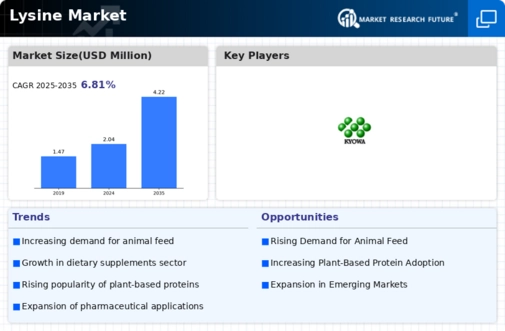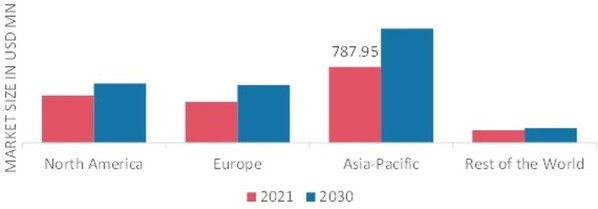Market Trends
Introduction
The Lysine market is entering a period of major transformation. Fermentation and genetic engineering are improving production efficiency and product quality. Regulatory developments in food safety and the environment are reshaping the industry. Health-conscious consumers are demanding more high-quality protein sources, which is also influencing the market. These trends are strategically important for market participants, as they not only determine their positioning in the market but also offer opportunities for innovation and collaboration in the supply chain.
Top Trends
-
Increased Demand for Animal Feed
Lysine, the principal constituent of mutton, is used in animal feed, and it is expected that by 2023 there will be an increase of 3 per cent in the output of this feed. The lysine industry is investing in the lysine production to meet this demand. The trend is expected to continue and it will influence the formulation of feed and the development of feed efficiency. -
Shift Towards Fermentation Technology
The fermentation process is a more sustainable method of producing lysine, and companies like Ajinomoto are investing heavily in this new technology. This method can reduce production costs by up to 20 percent, compared with the old method. This will raise the profile of lysine and thus attract the support of the broader food industry and consumers who are conscious of the environment. -
Regulatory Support for Sustainable Practices
Governments are promoting sustainable agriculture, which is affecting lysine production. In Europe, for example, the Green Deal, which aims to reduce greenhouse gas emissions from agriculture, encourages the development of lysine production in a sustainable manner. This regulatory framework is expected to encourage innovation and investment in sustainable lysine solutions. -
Rising Popularity of Plant-Based Diets
In the dietary sector, the growing trend towards vegetarian diets is affecting the lysine market. In 2023, according to a report, consumption of plant-based foodstuffs will increase by 15 percent. Consequently, companies are looking at ways of adding lysine to plant-based foods. This trend may result in new product developments and cooperation between lysine producers and food manufacturers. -
Focus on Health and Nutrition
In recent years, the attention paid to the nutritional and health aspects of the diet has increased, and the importance of lysine in the maintenance of human health has been recognized. This has led to the development of lysine-enriched nutritional supplements and foodstuffs. The market for lysine is thus expanding beyond the animal feed sector, as new opportunities are opening up in the health and nutrition sector. -
Technological Advancements in Production
The lysine content of the food products is increased by the precision fermentation and the genetic engineering. The companies claim an increase of output by up to thirty percent. This is expected to bring down the cost of lysine and increase its market share. -
Global Supply Chain Resilience
The COVID-IX epidemic had revealed the vulnerability of the world’s food chains. This led to a diversification of dietary strategies. Major players are now investing in local production to reduce their exposure to risk. This trend is likely to strengthen the lysine market’s supply chains and provide reliable supplies. -
Emerging Markets Driving Growth
In Asia and Africa, where meat consumption is increasing and livestock production is on the rise, lysine is becoming an important market. In 2023, the demand for lysine in these countries is expected to rise by 10 percent. This trend is likely to lead to new investments and alliances, thereby increasing the market presence of the major players. -
Increased Research and Development
In the lysine market, R&D is gaining importance and companies are devoting more resources to developing new products. For example, Evonik has increased its R&D budget by 25 percent to find new uses for lysine. This trend is expected to continue, as innovation is expected to drive the market and companies will need to keep up their game to stay in business. -
Consumer Awareness and Education
Moreover, lysine is now a recognized constituent of the human diet, and there is a growing demand for lysine-rich foods. The leading companies are investing in educating consumers about the role of lysine in health. This is a major factor in the growth of the market and is having an effect on the way companies market their products.
Conclusion: Navigating the Competitive Lysine Landscape
The lysine market in 2024 is characterized by intense competition and significant fragmentation, with the participation of both established and emerging players. The current regional trends point to the emergence of Asia-Pacific as the main growth region. This is why the market participants are preparing for this change in their strategies. The well-established players are relying on established supply chains and brand loyalty, while the emerging companies are focusing on innovation and sustainable development to attract the attention of consumers. The key to success in the future will be the ability to apply intelligent analysis and automation to production. Adapting to changing market demands will be the main way for suppliers to remain competitive.


 Source: Secondary Research, Primary Research, Market Research Future Database and Analyst Review
Source: Secondary Research, Primary Research, Market Research Future Database and Analyst Review

Leave a Comment